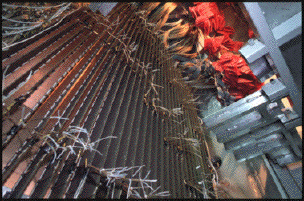Geneva, 14 May 2001. At a seminar at CERN1 on 10 May the NA48 collaboration announced its final result on one of nature's best-kept secrets : direct Charge Parity (CP)-violation. This subtle effect explains nature's preference for matter over antimatter.
Geneva, 14 May 2001. At a seminar at CERN1 on 10 May the NA48 collaboration announced its final result on one of nature's best-kept secrets : direct Charge Parity (CP)-violation. This subtle effect explains nature's preference for matter over antimatter.
The experiment announced the most precise measurement of the quantity that describes direct CP-violation in the decay of the neutral kaon particles. The value of the relevant parameter, epsilon prime over epsilon, (15.3 +/- 2.6) 10-4, is about six standard deviations from zero and demonstrates beyond doubt that direct CP-violation exists.
After 10 years of detector development, data collection and analysis, the new NA482 result is based on the observation of twenty million of CP violating neutral K meson decays. The tiny difference in the decay rates of neutral K mesons and their antiparticles has been determined with a precision of one part in a million.
At the birth of the Universe in the Big Bang, equal quantities of matter and antimatter should have been produced. Antimatter and matter mutually annihilate when they come into contact. So the equal quantities of the two forms of matter should have wiped each other out, leaving nothing. However, we live in a matter Universe. The existence of direct CP violation helps to explain Nature's preference for matter over antimatter and is a foundation for understanding why we are here at all.
The study of direct CP violation is an excellent example of the rigour involved in the establishment of scientific fact. The first experiments took place at CERN with the NA31 experiment and at Fermi National Accelerator Laboratory (Fermilab) in the USA with the E731 experiment. Results published in 1993 were not precise enough to confirm that direct CP-violation was a real effect. More accurate measurements were clearly needed, and ambitious new experiments at the two laboratories - NA48 and KTeV - soon rose to the challenge. Both have now measured the effect with several times greater precision than their predecessors and both results conclude that direct CP violation exists. The new result from CERN confirms with greater precision the 1993 NA31 observation of direct CP-violation.
Charge Parity (CP) violation boils down to the concept of symmetry. Both C and P are symmetries that are conserved in most particle interactions. C, represents swapping the charges of all the particles in an interaction, in other words, swapping particles and antiparticles. P is called parity and it corresponds to looking in a mirror that reverses all three spatial co-ordinates. Physicists once thought that both C and P were conserved in particle interactions, but in 1956 T.D. Lee and C.N. Yang demonstrated that P could be violated in weak interactions. However, the combination of C and P was still thought to be conserved, but this too proved not to be the case.
CP-violation was first observed at the US Brookhaven laboratory by Christenson, Cronin, Fitch and Turlay in 1964 when their Nobel prize winning experiment showed that particles called long-lived neutral kaons occasionally decay into two pions, a CP-violating process. However, the origin of this process remained mysterious. To incorporate CP-violation into the theory of weak interactions, a demonstration of CP violation in the decay of a quark was necessary Ð direct CP-violation. The long and rigorous research carried out at CERN and Fermilab has now established direct CP-violation as fact.
For more information:
- NA48 experiment
- Our previous press release on the subject
- Fermi National Accelerator Laboratory
- Fermilab's KTeV experiment
2. The NA48 experiment is carried out by a collaboration of physicists from institutes and laboratories at Cagliari, Cambridge, CERN, Dubna, Edinburgh, Ferrara, Florence, Mainz, Orsay, Perugia, Pisa, Saclay, Siegen, Turin, Vienna and Warsaw.

